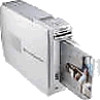Sony DPP-EX50 Operating Instructions - Page 130
About the CompactFlash card, Notes on use
 |
UPC - 027242639546
View all Sony DPP-EX50 manuals
Add to My Manuals
Save this manual to your list of manuals |
Page 130 highlights
• Avoid getting liquids on the "Memory Stick" or using it in areas subject to high humidity. • Avoid using or storing the "Memory Stick" in a location subject to: - extremely high temperature such as the hot inside of a car or the outdoors exposed to direct sunlight, or a place near a heater. - direct sunlight - high humidity - corrosive substances • When formatting a "Memory Stick", use the format function of the printer or your digital camera. If you format a "Memory Stick" with your computer, images may not be displayed properly. About the CompactFlash card The printer can read and write a CompactFlash card (CF+ Type I/Type II flash memory cards with a power specification of 5V or 3.3/5V). By using a commercially available CompactFlash card adaptor, you can also use SD Memory Card, xD-Picture Card, and Smart Media cards. Notes on use • You cannot use CompactFlash cards with a power specification of 3V (3.3V) only. Do not insert other types of CompactFlash card into the printer's insertion slot. The printer may be damaged. • Do not drop, bend, or submit the CompactFlash card to external shock. • Do not disassemble or modify the CompactFlash card. • Avoid getting liquids on the CompactFlash card or using them in areas subject to high humidity. Otherwise, data may be rendered unreadable. • Avoid using or storing the CompactFlash card in a location subject to: - extremely high temperature such as the hot inside of a car or the outdoors exposed to a direct sunlight, or a place near a heater. - direct sunlight - high humidity - corrosive substances 130 GB















